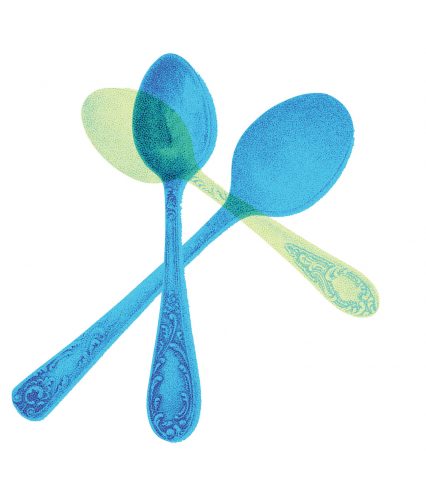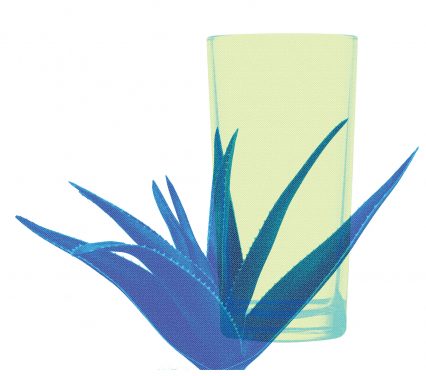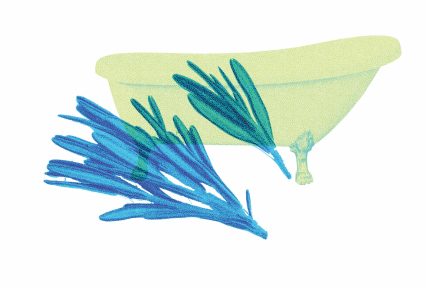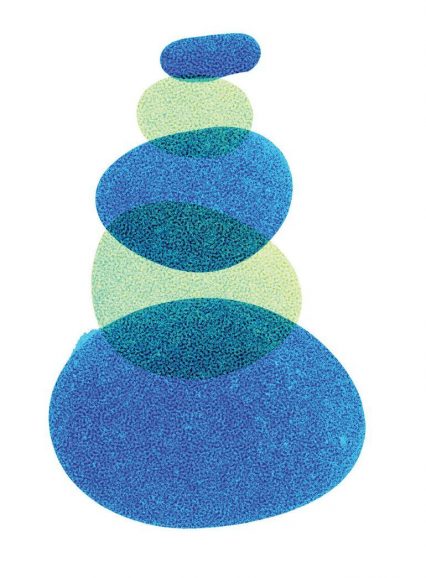
19 Cooling Practices
dashu83/Getty
Struggling to escape the heat? Cool it with tips from Ayurveda, yoga, Western herbalism, traditional Chinese medicine, and everyday common sense.
1. Incorporate mint into your diet.
The menthol in mint triggers a reaction in our brains to make us think our temperature is lowering. If you’re growing your own, experiment with different varieties such as chocolate mint or orange mint. Plus, mint works double-duty for digestive support.
2. Relax and rejuvenate the face and eyes with chamomile.
Aomi Richter, the owner of Evolve Skin Studio in Asheville, NC, suggests using cooling, calming chamomile for the eyes and face: “Brew a strong cup of chamomile tea. Take two cotton rounds, soak them in the tea, squeeze out any excess, place in a small sandwich bag, and store in the fridge.” Place on the eyes when you’re feeling overheated or puffy.
Richter suggests making a cooling full-face mask by wetting a paper towel or a thin washcloth with your brewed tea. Cool the cloth in the fridge, and when you need to chill, place the towel or cloth over your face. “This can be particularly helpful for skin irritations such as eczema, hives, or generally overheated skin,” Richter notes.

3. Break out the spoons.
Richter also loves a simple but time-tested cooling tool: cold spoons. “There are a lot of cooling facial tools on the market,” she says, “but you have a free one in your kitchen right now. Leave a couple spoons in the fridge, and use as needed as an instant facial cooling tool.”
4. Lift your spirits with lemon balm iced tea.
Mood-elevating lemon balm (sometimes referred to as Melissa or Melissa balm) makes an exceptional chilled drink because of its potent citronella-like flavor and soothing medicinal qualities. The fragrant terpenes in lemon balm contribute to the herb’s calming effect. Use fresh lemon balm for the best flavor and most potent medicinal properties. Brew a strong tea and serve over ice.
5. Kick your legs up the wall in viparita karani.
Dr. Robert Saper, chair of wellness and preventative medicine at the Cleveland Clinic, states that this posture helps increase circulation, a process that the Mayo Clinic states is essential for regulating body temperature. This pose, which many of Dr. Saper’s clients find calming, can be done with or without props. Sit on the floor with one hip to the wall, and swing your legs up against the wall, scooching your hips as close as you can to the wall. You may enjoy a pillow under the hips or head. If you feel tingling in your toes and feet, bend your knees and/or gently role out of the pose.
6. Align your dietary choices with Ayurvedic wisdom.
Kate O’Donnell, author of The Everyday Ayurveda Cookbook and The Everyday Ayurveda Guide to Self-Care, says to avoid “things that heat the inside of the body, such as alcohol, ferments, spicy food, and acidic fruits and vegetables such as oranges and tomatoes. Enjoy lighter foods such as legumes, rice, quinoa, coconut, juicy sweet fruits, and fresh cooling vegetables like cucumber, cilantro, and zucchini.”

7. Drink your aloe.
O’Donnell also recommends aloe vera juice, which can be found in the supplement section of many grocery stores. Look for pure aloe vera juice, and follow the brand’s recommendations on the bottle—too much may have a laxative effect.
8. Swap heavy cooking fats for coconut oil.
Per Ayurveda expert Vasant Lad, coconut oil is more cooling than other oils. Coconut oil can be used as a substitute in sautees and curries and is easily incorporated into desserts.
9. Refresh with watermelon.
Dr. Jenelle Kim, a doctor of Chinese medicine and the author of Myung Sung: The Korean Art of Living Meditation, recommends watermelon, which is one of the most well-known herbal ingredients in traditional Chinese medicine. She adds “other herbs that are known to quickly cool the body include mung bean, chrysanthemum, and dandelion,” as well as bitter vegetables. Want to try a spin on Dr. Kim’s advice? Freeze small chunks of watermelon for a delicious summer smoothie.
10. Eat cold oats.
Overnight oats are an easy, inexpensive way to prepare a nutritious, cooling breakfast. It’s as easy as combining 1/2 cup of quick-cook oats, 1 mashed ripe banana (or 1/2 cup of yogurt), 1/2 cup milk of your choice, and 1 tablespoon chia or ground flax in a jar and refrigerating overnight. Add your favorite seasonal fruit, a sprinkle of cacao nibs, or a swirl of nut butter for more texture and flavor.
11. Swap hot soups and stir fries for salads.
Pile your plate high with iceberg or romaine lettuce (which are full of water and super hydrating), other fresh chopped greens, and pack a rainbow of raw veggies, including celery, carrot, cucumber, and tomatoes, as well as some sunflower seeds or walnuts, avocado, and a protein of your choice to fill you up. Drizzle with a light dressing.

12. Take a cooling herbal bath.
Make a strong herbal tea with your favorite body-safe, fragrant herbs, then add the tea to a filled bath of cool water. Lavender is a reliable favorite, and rosemary is often found in the kitchen or growing in the garden.
13. Replace hot coffee with cold.
Cold-brew coffee is exceptionally easy to make on your own. The basic concept is to steep coarsely ground coffee in water for about 12 hours. Flavoring agents like vanilla bean, cinnamon sticks, and cacao can be added with the grounds. Filter out the beans and you have a dense, delicious coffee elixir. Serve over ice, dilute with filtered water if desired, and add a splash of milk or milk alternative for extra creaminess.
14. Sleep on a new surface.
If your air conditioning isn’t cutting it overnight, try a cooling mattress or mattress topper to regulate your body temperature. These are made of gel or breathable organic materials and lay over your existing mattress.

15. Go to the woods.
Julia Plevin, author of The Healing Magic of Forest Bathing and founder of the Forest Bathing Club, shares her thoughts on forest bathing: “When you’re feeling hot, head to the forest, where trees provide shade from the scorching sun and cool the air through a process of transpiration cooling. As trees release water into the atmosphere from their leaves via transpiration,the surrounding air is cooled as water transforms from liquid to vapor.”
Forest bathing is about slowing down in nature. Try packing a picnic, taking a nap, or dipping your feet in a creek.
16. Grow your own sprouts.
Water-rich raw vegetables are widely suggested as cooling foods in a variety of traditions, and sprouts are no exception. Alfalfa sprouts and sprouts from other seeds are marvelously easy to grow at home. You can use a jar that comes with a sprouting lid or simply use a mason jar covered in cheesecloth.
17. Blend some electrolyte lemonade.
Add a bit of lemon or lime juice, a pinch of sea salt or Himalayan salt, and stevia drops (or honey, maple syrup, or monk fruit sweetener) to your water for a refreshing, deeply hydrating, lemonade-style drink.

18. Use river stones.
Plevin shares another cooling tactic: “I like to place cold stones from a river bed on my body to help cool me down. As I do, I imagine that the stones collect any inflammation or negative energy that is stored in my body.” After using the stones, Plevin gratefully returns them to the earth.
19. Wear airy clothes.
You can go with high-tech materials or the familiar cotton and linen. Here’s a test originally suggested by George Havenith in Popular Science: Try to blow through your clothes. Put your mouth right next to the fabric and blow. If your breathe easily penetrates, that suggests it’s a good summer option, since the layer of air beneath your clothes and next to your skin will be able to constantly refresh.
All photos in this article courtesy gettyimages.com. Spirituality & Health illustrations.






